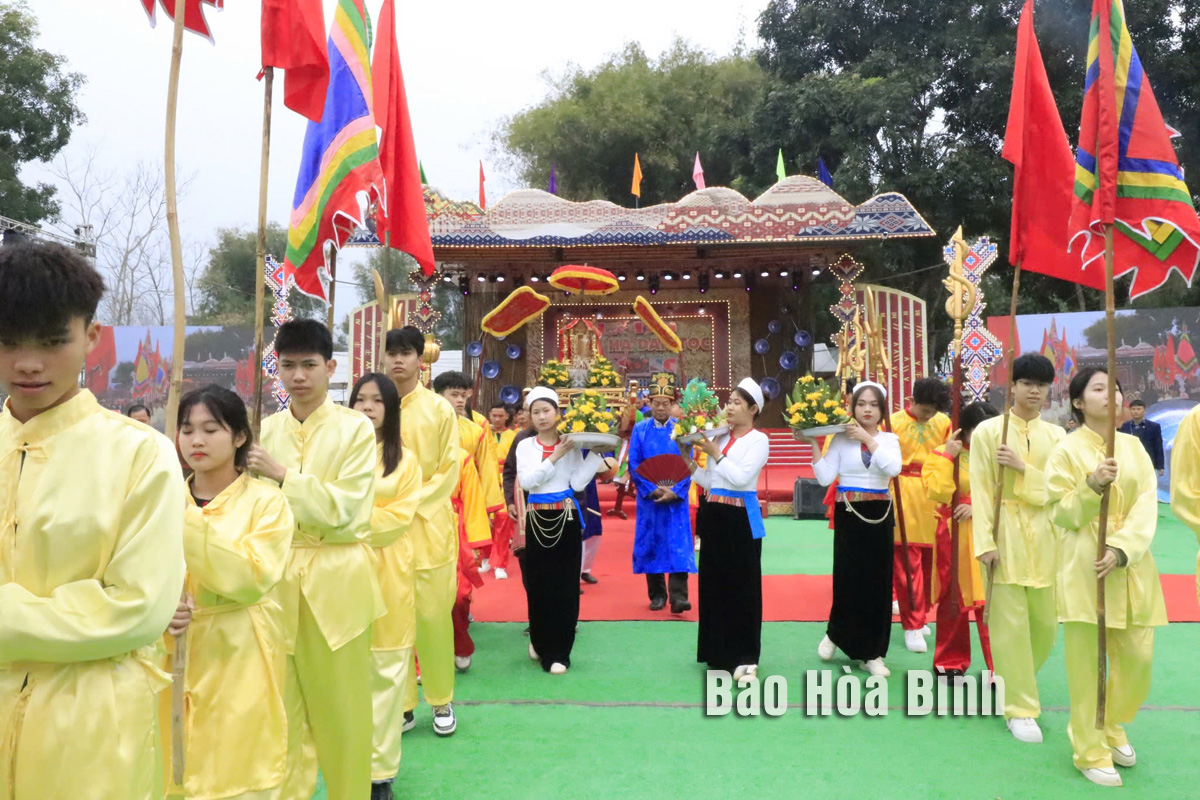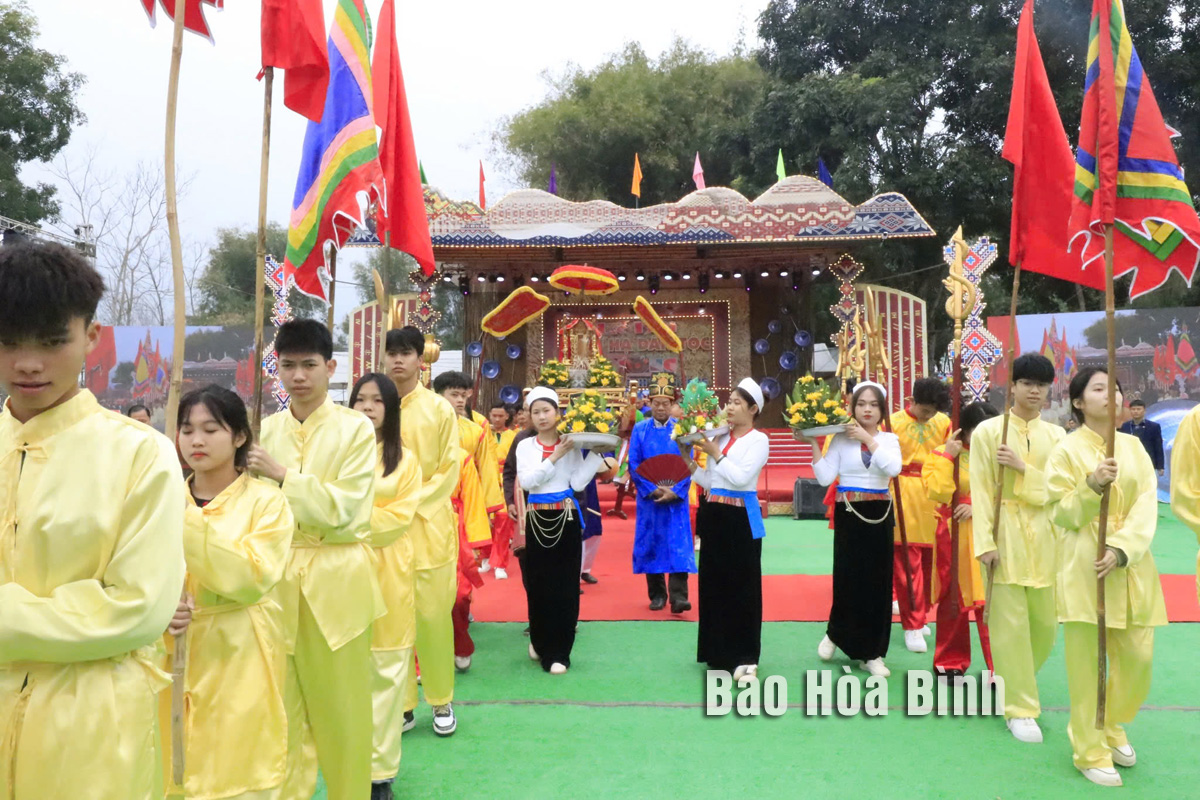
For generations, the ethnic communities of Hoa Binh province, particularly the Muong people, have preserved vibrant festivals deeply intertwined with the region’s geography, nature, and social traditions. These celebrations enrich Hoa Binh’s spiritual life and cultural identity, reflecting both folk beliefs and the intermingling of ethnic customs. Many of these festivals have endured the test of time, passed down through generations and continuing to thrive today. Among them, the Khai Ha (Going Down to the Field) festival stands out as one of the most significant events of the Muong ethnic group.

The Gau Tao festival of the Mong people in Mai Chau
district always leaves a special impression on visitors from near and far.
Recognised
in 2022 by the Ministry of Culture, Sports, and Tourism as a national
intangible cultural heritage, the Khai Ha festival is the largest traditional
folk festival of the Muong people in Hoa Binh. Closely linked to wet rice
cultivation, it bears influence of ancient Vietnamese civilisation. For centuries,
it has been an indispensable cultural and spiritual tradition, celebrated
during the Lunar New Year and spring across the four major Muong areas: Bi,
Vang, Thang, and Dong. The festival serves as a prayer for abundant harvests
and communal prosperity, while also offering the Muong people a time to rest
and express their hopes for peace and well-being. In recent years, it has
expanded with additional rituals and activities, attracting increasing numbers
of participants.
Another
cherished tradition is the Sac Bua festival, a joyful and entertaining event
that has been preserved and widely practiced within the Muong community since
ancient times. Held at the start of the new year, this festival brings people
together to exchange good wishes for fortune and health. It is also observed on
special occasions such as housewarmings, weddings, and when welcoming esteemed
guests.
Beyond
the Khai Ha and Sac Bua festivals, the Muong people celebrate other significant
events, including the rain praying festival, the new rice festival, and the
bamboo swing festival. Additionally, several local festivals in various
districts are associated with historical legends and notable landmarks. Over
time, these celebrations have grown in scale and recognition, attracting
visitors from both within and beyond the province. Notable examples include the
Dinh Coi Festival (Vu Binh commune, Lac Son district), Dinh Vai Festival (Ba
Hang Doi town, Lac Thuy district), Trung Bao Temple and Shrine Festival (Thanh
Cao commune, Luong Son district), Dinh Xam Festival (Phu Lai commune, Yen Thuy
district), and Chua Tien Festival (Phu Nghia commune, Lac Thuy district).
Among
these, the Bo Temple Festival has gained considerable attention from visitors
nationwide. According to legend, the Thac Bo Goddesses—Dinh Thi Van, a Muong
woman, and an unidentified woman from the Dao ethnic group in Vay Nua
commune—played a crucial role in aiding King Le Loi (1384–1433). They provided
food and boats to help the king cross Bo Waterfall and defeat the Deo Cat Han rebels
in Muong Le, Son La province. In gratitude for their contributions, King Le Loi
issued a royal decree for the construction of a temple in their honour. Every
year, on the seventh day of the first lunar month, a festival is held to
commemorate these heroic women and other deities. Today, Bo Temple is not only
a revered spiritual site but also a key attraction in Hoa Binh Lake tourism.
Many families and visitors embark on pilgrimages at the beginning of the year
to pray for peace and prosperity, and in recent years, the temple’s festival
has drawn an increasing number of visitors from across the country.
In
addition tothe Muong community, other ethnic groups in Hoa Binh—such as
the Thai, Tay, Mong, and Dao—also celebrate distinctive festivals that showcase
their unique cultural heritage. One of the most prominent Thai festivals in Mai
Chau is Xen Ban, a celebration of gratitude toward ancestors and prayers for
prosperity, favourable weather, bountiful harvests, and happiness. Festival
activities include folk singing, traditional dances, drum and gong
performances, and cockfighting. Having faded into obscurity over time, the
festival was revived in 2011 by Mai Chau district, preserving its original
rituals and cultural significance. In 2024, Keng Loong (a traditional Thai folk
dance) and the Xen Muong Festival were officially recognised as national
intangible cultural heritages.
Other festivals among Hoa Binh’s ethnic minorities reflect deeply rooted
traditions, such as the Dao people’s Cap Sac (Coming-of-Age) ritual. In
response to modern developments, many traditional festivals have adapted to
contemporary times by integrating elements of economic and tourism promotion.
For example, the Cao Phong Orange Festival highlights a local specialty.
As these cultural festivals continue to uphold meaningful social values, foster
unity, and strengthen community bonds, they remain integral to the identity of
Hoa Binh. With ongoing efforts to preserve and promote these traditions, they
will continue to thrive for generations to come.
The People's Committee of Lo Son commune, Tan Lac district, has organised the local annual traditional stream fishing festival on April 19 - 20.
As a land deeply intertwined with human history and Vietnam’s millennia-long journey of nation-building and defence, Hoa Binh is often revered for its epic tales and legends.
Residents of Hoa Binh boast a rich cultural identity, reflected in their unique language, traditional attire, customs, and folk melodies – described as "sweet as honey, clear as a mountain stream.”
Lac Son district’s Vu ban town held the 2025 Truong Kha temple festival on April 12–13 (the 15th–16th days of the third lunar month). Since its revival in 2019, the festival has been organised every three years, preserving valuable intangible heritage while meeting the community’s cultural and spiritual needs.
The clothing of women reflects the culture of the Muong, Thai, Tay, Dao, and Mong ethnic groups in the northern province of Hoa Binh.
Gongs hold a special place in the cultural and spiritual life of the Muong ethnic people in Hoa Binh province. More than musical instruments, they are an indispensable part of community rituals and collective memory, echoing through generations as a spiritual thread linking the past, present, and future.



